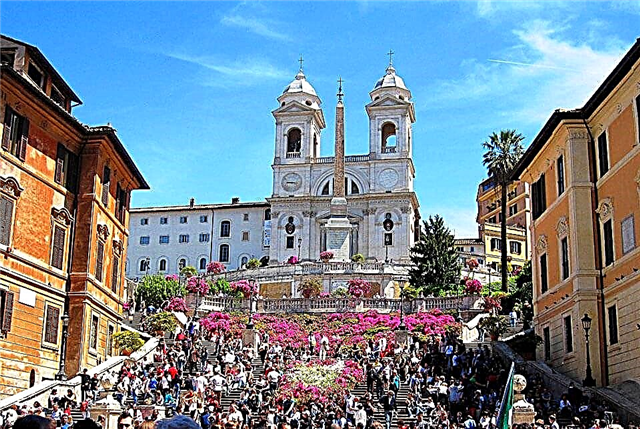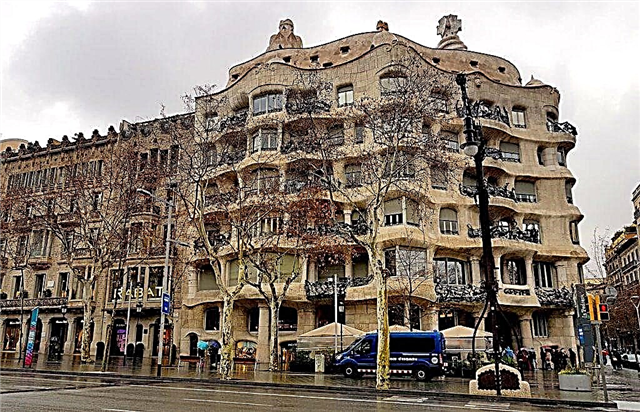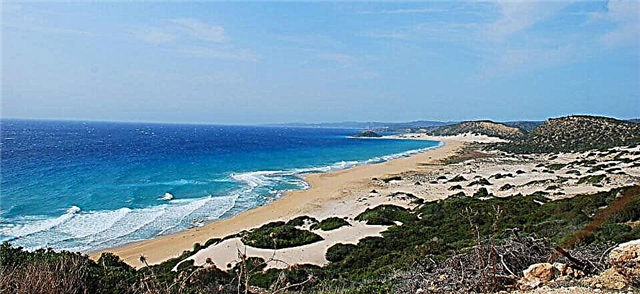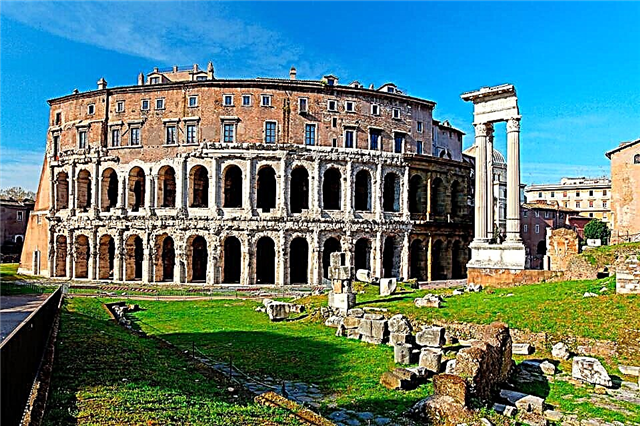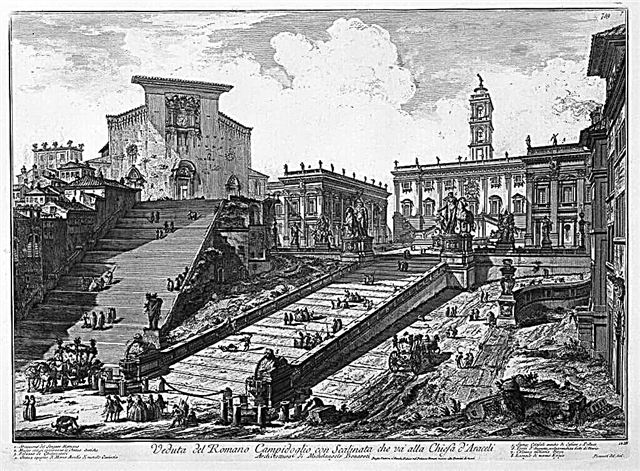Rome is located on seven hills. The smallest in size and height, but the most significant in terms of historical and artistic value is called the Capitoline. Every tourist tries to visit this place in order to see with his own eyes the place where the Eternal City arose.
History and ancient temples of the Capitol
There are many beautiful and unique places in Rome: cathedrals, monuments to famous personalities, fountains and palaces. The most impressive is Capitol Hill, its historical and cultural values leave no one indifferent. According to legend, 2.5 thousand years ago Romulus (one of the founding brothers of Rome), standing on the top of a hill, saw eagles soaring in the sky. It was near this place that he decided to found a city. Historians have not come to a consensus about the origin of the name of the hills. There are two versions, one by one it bears the name of Jupiter Capitoline, whose temple stood long before the appearance of Romulus. Here was the sanctuary of the Sabine tribes, they erected a temple to Jupiter and prayed to him, offering sacrifices.
The second version is from the word "kaput" (translated as head), since the Senate was located on the hill, where the most eminent and noble dignitaries of that time sat. In ancient times, a temple to Jupiter, Juno and Minerva was built on the Capitol Hill, there were always a lot of people on the square, the Senate gathered here, important issues were resolved, and courts were held. The building of the Mamertine Prison, which also stands on a hill, has survived to this day. It is over 2700 years old. According to some sources, the date of construction belongs to the VI, according to others, it was built in the IY century BC. Initially, it was a two-level structure, in its dungeon, both important dignitaries and the most ordinary townspeople languished in anticipation of the execution of the sentence.
According to legend, the apostles Peter and Paul were in this prison before their execution. When the prison ceased to function in XYI, an altar was erected in the dungeon, and pilgrims still come here to bow. Subsequently, the church of Joseph the Plotnik was erected over the underground. In ancient times, on the territory of the Capitol, there were streets with stalls and shops, where artisans sold their products. Some have survived to this day, for example, Silver, where, according to the name, silver items were sold.
At the foot of the Temple of Aricheli there are ancient buildings - insuls, in fact, this is a multi-apartment hostel, in the image of which modern hotels and inns began to settle down. The first multi-storey buildings appeared in the 3rd century BC, and the mass construction of "communal apartments" in Rome began in the 1st century. Insuls were rented out, and the lower the floor, the more expensive was the payment for living and the more wealthy people settled in it. There were even sewerage and running water on the first floors. Houses were located close to each other, so often whole neighborhoods were destroyed by fires. They quickly collapsed, as they were built in violation of the rules, fell into decay, but such "apartments" were not cheap.
Michelangelo and the revival of the Capitol

Ancient buildings required restoration; these works were commissioned by the famous sculptor and architect Michelangelo by Pope Paul III. Michelangelo (years of life: March 6, 1475 - February 18, 1564) designed many buildings, including St. Peter's Basilica in Rome. At the end of the thirties, he began to re-equip the Capitoline Square. Unfortunately, Michelangelo died before he could complete the construction, this was done by his students and followers.
The Capitol Square is considered unique in its beauty and harmony - in its central part of the square there is the Senatorial Palace. On one side of it, the Palazzo Nuovo was erected, on the other - the Palace of the Conservatives, they were built according to the same project, therefore, they are exactly the same. They now house museums, where canvases of old masters, clothes of different eras, dishes, coins and figurines are presented.
In the center of the square is a sculpture of the emperor Marcus Aurelius, emperor and philosopher. This is a copy of an antique statue. From one side of the square, you can go down the ancient staircase, which is decorated with statues of Egyptian lions and sculptures of marble twins - Pollux and Castor. They were discovered in Pompeii and transported to the capital of Italy in the 11th century. At the bottom there are statues of Constantine and Constantine II, sculptures from an antique fountain and milestones from the Allieva road.
Palace of the Senators

The most remarkable building is the Palace of the Senators, built in the first century BC. the architect Cornelius. Initially, the Palace housed an archive for a long time, in the Middle Ages it was empty and gradually collapsed. The revival of the palace began in the thirties of the XYI century, when Pope Paul III entrusted Michelangelo to carry out the reconstruction of buildings and equip the square, which was called Piazza-del-Campidolio. According to the plan of the architect, the dominant and most majestic building was supposed to be the central building - the Palace of Senators. Since 1871, the palace has been the residence of the mayor, so most of the premises are closed to tourists. You can visit the Lapidarium, where antique stone slabs with inscriptions are exhibited. Below, in the old part, you can see the archive - Tabularium.
Palace of the Conservatives
The first building of the Palace of the Conservatives was erected during the reign of Pope Nicholas Y in the second quarter of the XY century. Literally translated, the word means "The Palace of the Guardians". Senators, magisters and judges, who were called conservatives, sat in this room, which gave the name to the building. All power was concentrated in the hands of these people. But over time, the papal power increased and the importance of the city significantly decreased, the treasury was depleted, which led to the desolation and dilapidation of the building. In the middle of the XYI century, the palace, like the entire architectural ensemble of the square, was reconstructed by Michelangelo.
Now the building houses museums, the first exhibits belonged to Pope Sixtus IY, he donated antique sculptures made of bronze in 1471, including the sculpture of the legendary “Capitoline she-wolf”, according to legend, who nurtured Rem and Romulus. In the central hall, richly painted with frescoes, marble ancient Roman busts are exhibited. On the second floor there is a gallery (Pinakothek). It features works by Caravaggio, Van Dyck, Tintoretto and other famous artists. Ancient Greek and Etruscan artifacts and jewelry are exhibited in the Castellana Hall.
Nuovo Palace

Palazzo Nuevo (New Palace), as the name suggests, is the newest building dating back to the XYII century. As planned by Michelangelo Buonarotti, it was a copy of the Palace of the Conservatives. It was originally built as a public museum and was opened to the public in 1734. Nowadays, the palace houses part of the Capitoline Museums. Visitors can see sculptures, vases brought from Greece, paintings by artists, ancient mosaics. In the courtyard, parts of buildings and fragments of the statue of Constantine are displayed - an arm, a foot, and a head.
In the modern part of the building there is an original bronze sculpture of Marcus Aurelius - a unique similar exhibit that has been preserved since ancient times. A beautiful Scalone staircase leads to the second floor of the palazzo; it is richly decorated with relief paintings on antique subjects and inlaid with marble.
Basilica of Santa Maria in Araceli

The Church of the Holy Virgin Mary was founded in the 13th century. The Capitol is a hill with two low peaks, on the smaller of which the church is built. According to ancient legends, a temple was erected on this peak to Jupiter, his wife and daughter Minerva, the Goddess of wisdom. Then she got her own palace - the temple of Juno-Coin, it was on this place that the Church of the Virgin Mary was subsequently erected.
Historians do not have exact information about the first buildings.They are based on medieval legends, which say: when the emperor Augustus ruled, the senators decided to build a church in his honor. The emperor wanted to ask the gods whether it was worth doing and went up the hill, wanting to sacrifice pigeons to them.
On the way he met a sibyl, a soothsayer. She exclaimed that she sees the birth of God, soon they will only pray to him. The Emperor set up the Heavenly Altar where the vision came to the sorceress. Then the church of Santa Maria in Aracheli appeared here, the first documentary mention of it dates back to the first quarter of the XIY century. In the 6th century a Greek monastery was built, then in the 9th century the Benedictines erected a Catholic church. In the 13th century, it passed to the Franciscan order, they carried out a significant reconstruction of the building. In the Middle Ages, people not only prayed here, but meetings of the people were held - laws were proclaimed, and economic issues were resolved.
In 1347, Cola di Rienzo, a politician, took power in Rome, he ordered the construction of a grand staircase that led from the base of the hill to the entrance of the church. In 1464, the basilica was restored again, in the middle of the 11th century, a sacristy and a bell tower were added to it, in 1565 a choir was erected, and in 1575 a beautiful carved ceiling was made in honor of the victory of the Italian fleet over the Turkish one. Nowadays, the cathedral is open to believers and tourists who want to admire the beautiful interior design of the basilica.
Opening hours and ticket prices
The palaces, which are part of the museum, work at the same time and you can visit them by purchasing one ticket:
Opening hours: Tuesday to Sunday from 9:00 to 20:00. The day off is Monday.
Ticket prices: complex - 15 euros, concessionary - 13 euros.
Mamertine Prison. The museum in the prison is open from 9:19 am, the entrance ticket costs 10 euros. It has also become a tradition to leave donations at your own discretion.
The Basilica can be visited from 8:00 am to 5:30 pm. The entrance is free.
Where is it and how to get there
Address: Piazza del Campidolio, Rome, Italy. The Capitol is located close to Piazza Venezia and the Roman Forum. The easiest way to get there is by metro station Colosseo, line B. By buses NoNo 30, 51, 81 118, 628 and 810 to the Ara Coeki-Piazza Venezia stop. Take tram number 8 to the Venezia stop.
An indelible impression remains from visiting sunny Italy - its beautiful nature, warm sea and beaches, wonderful cuisine. But the monuments of ancient and medieval antiquity overshadow everything, they amaze and remain in the memory forever.




